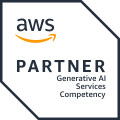Why Edge AI Is the New Cloud for Real-Time Intelligence
TL'DR
Edge AI is the architectural shift behind the next generation of intelligent applications..
- Privacy-first: Keeps sensitive data on-device, reducing attack surfaces
- Real-time performance: Eliminates latency with local inference
- Personalization at scale: Delivers context-aware intelligence tuned to each user
- Hybrid AI future: Edge and cloud are co-pilots not competitors
Edge AI is already being embedded in wearables, AR/VR headsets, cars, and smartphones. In a world demanding immediacy, trust, and autonomy, AI has to move closer to the user.
Edge Is Where AI Meets Reality
As enterprises scale AI workloads and consumer expectations demand ultra-responsive, deeply personal experiences, the cloud alone can’t keep up. Latency, cost, compliance, and context-awareness are breaking points. That’s why 2025 marks a turning point: AI is being pushed to the edge.
Edge AI is a business and product imperative. Whether in healthcare, automotive, finance, or industrial IoT, AI that lives closer to data sources unlocks performance, trust, and user delight at scale. Recent projections estimate the Edge AI market at USD 20.8 billion in 2024, with expectations to reach USD 66.5 billion by 2030 a compound annual growth rate (CAGR) of 21.7 percent.
This blog unpacks the why, where, and how of Edge AI: the privacy model, the latency breakthroughs, the architecture patterns, and the real-world deployment lessons across sectors.
What Is Edge AI?
Edge AI refers to the deployment and execution of AI models on edge devices smartphones, wearables, vehicles, and industrial sensors, rather than relying on centralized cloud infrastructure. These devices process data locally, making AI decisions instantly and privately.
The market for Edge AI software is also accelerating, with forecasts of CAGR 6.2 percent from 2025. These trends demonstrate that businesses are investing heavily in localized intelligence for better speed, privacy, and control.
1. Privacy by Design:
Edge AI executes inference locally, which means raw data remains on-device. That dramatically reduces the risk of breaches and cloud misuse. This design aligns with zero-trust and data sovereignty frameworks such as GDPR and India’s DPDP Act. Highly regulated sectors healthcare, finance, and enterprise IT, benefit most. For example, health wearables can now process arrhythmia alerts without sending sensitive biometric data to the cloud.
Why it matters:
- Centralized AI architectures require transmitting user data to the cloud for inference.
- Every transmission is a potential leak, a compliance risk, and a performance tax.
- Edge AI short-circuits this by processing sensitive data, voice, health metrics, and financial behavior right where it’s generated.
Industry use cases:
- Healthcare: Wearables analyze vitals locally without violating HIPAA boundaries.
- Finance: Mobile apps detect fraud patterns without exposing transaction trails.
- Workforce IT: Behavioral analytics stay on the device, aligning with zero-trust models.
Bottom line: Edge AI aligns with evolving data sovereignty laws (e.g., GDPR, India’s DPDP Act), making it an enterprise ally in a compliance-first world.
2. Real-Time Personalization:
Local AI models adapt to users based on ambient context, behavior, and temporal factors. When voice assistants detect frustration in a user’s tone, they can adjust their responses. Modern wearables fact-check exercise recommendations against local temperature. Cars adapt navigation styles based on driving behavior. This capability is enabled by on-device sensors and processors that continuously learn and adjust in context.
How it personalizes:
- Edge AI leverages environmental context (light, noise, location)
- It processes user signals (tone, behavior, preferences)
- It adapts to temporal relevance (what matters right now)
Examples:
- A voice assistant modulates tone based on detected user stress.
- A fitness wearable adapts recommendations based on temperature and sleep history.
- A car adjusts driving prompts based on driver habits and surroundings.
Cloud AI models learn from millions. Edge AI models learn from only you.
3. Speed Is UX:
In AI UX, response time is product quality. Every 100ms delay can reduce engagement, NPS, and trust. Edge AI cuts latency down to the silicon.
Latency Delta:
- Cloud AI: Round-trip latency = 300–800ms
- Edge AI: On-device inference = 10–50ms
Where speed = safety:
- Autonomous driving: Split-second decisions without cloud reliance
- AR/VR: Real-time overlay rendering
- Customer service: Instantaneous GenAI replies and summarization
With NPUs becoming standard in mobile SoCs, on-device inference is now table stakes, not a tradeoff.
4. Edge vs Cloud AI:
The future is a distributed intelligence stack. Here’s how they work together:
Modern pattern:
- Pre-train large models in the cloud (e.g., Llama 3, GPT-4o)
- Fine-tune for tasks and deploy to edge devices
- Use the cloud for heavy compute, edge for immediate action
Wide-scale practices now involve training models in the cloud, fine-tuning for specific tasks, and deploying them on edge devices. Heavy computations remain in the cloud; immediate needs are handled locally.
5. The Silicon Race for the Edge
What makes Edge AI feasible is the hardware evolution.
Platform readiness:
- Smartphones: Snapdragon with Hexagon NPUs, Apple Neural Engine
- Wearables: Custom ML chips for real-time health inference
- Cars: ADAS SoCs for driver monitoring + autonomous ops
- AR/VR: On-device depth sensing, emotion tracking, spatial reasoning
Constraints = Innovation:
- Memory: 8GB–16GB RAM limits bloat, forcing model efficiency
- Power: Edge inference must be battery-friendly
- Storage: Models must compress without losing performance
These platforms are effective because model size is constrained to 8–16 GB RAM and must preserve battery life and storage capacity. This limitation compels efficiency in design and deployment.
AI engineering shifts from "more compute" to "smarter compute."
See our comparison of leading-edge devices: Edge Computing Devices: Performance vs Deployment Tradeoffs
6. Edge-Native Models:
One of the most promising trends is the rise of task-specific LLMs and distilled models that outperform general-purpose models when:
- Domain is narrow (e.g., in-vehicle assistants)
- Response time is critical
- Context is hyper-local (user, location, time)
With techniques like quantization, pruning, and knowledge distillation, small models running on-device now rival large models running in the cloud.
Performance benchmarks:
- Tiny LLMs (500M – 2B params) now rival 7B+ models for narrow tasks
- On-device models reach >90% accuracy on context-specific prompts
These improvements are supported by semiconductor advancements. Edge AI chips are projected to grow from USD 10.1 billion in 2025 to USD 113.7 billion in 2034 at a CAGR of 30.8 percent.
Further reading: LLM Optimization Techniques for Real-World Applications
7. Deployment Realities:
Geo & sector variation:
- China: Rapid edge adoption across retail, surveillance, and smart homes
- US/EU: Heavily regulated, prioritizing explainability and reliability
- India/LatAm: Mobile-first edge adoption in fintech, agritech, and edtech
Enterprise concerns:
- Model validation: How do we trust edge inference?
- Update strategy: How do we patch/update models securely?
- Data governance: Who owns the edge training data?
From a technical standpoint, enterprises face challenges in model validation, secure updates, and data governance. Solutions require AI-ready deployment pipelines, version control, and reliable edge OTA (over‑the‑air) update systems.
8. Real-World Applications: Edge in Action
Key advantage: These systems don’t wait for instructions they respond instantly, privately, and in context.
Audio Classification on Edge AI How on-device sound classification systems are built for low-latency environments.
9. Why Now: Edge AI Is the Shift Already Happening
Enterprises that adopt Edge AI don’t just gain performance they redefine what’s possible.
The shift:
- From centralized intelligence to distributed cognition
- From generic models to user-centric personalization
- From latency-bound apps to zero-delay experiences
Cloud infrastructure is costly and centralizing data creates inefficiencies. For comparison, public cloud spending is expected to reach USD 1.3 trillion by 2025 . Analysts at Reuters project edge AI adoption to generate a USD 700 billion opportunity across smartphones and PCs by 2027 . A report from IMARC estimates growth from USD 18.3 billion in 2024 to USD 84 billion by 2033.
Intelligence Must Live Closer to the User
The future of AI isn’t a server farm. It’s the device in your hand, the wearable on your wrist, the car you drive, and the headset you wear. It’s intelligence that respects your privacy, reacts instantly, and adapts to your world.
It moves computing to where it belongs: close to the user. It ensures faster responses, superior privacy, and meaningful personalization. Monthly expenditures and infrastructural costs are real, but the ROI is immediate: higher user trust, faster interfaces, and compliance with privacy regulations.
Enterprises that adopt Edge AI now can offer intelligent services that protect data, respond instantly, and deliver relevance at scale. At Ideas2IT, we engineer Edge AI systems that do more than compute; they connect, understand, and deliver value where it matters most: next to the user.







.png)
.png)
.png)
.png)
.png)
.png)












